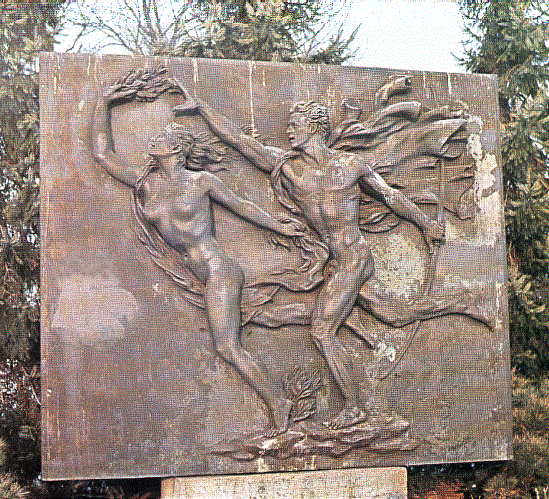
APOLLO AND DAPHNE, a monumental bronze relief by Arno Breker.

APOLLO AND DAPHNE, a monumental bronze relief by Arno Breker.
The central motif of my work was always the human being, man or woman. The ever-varying forms of appearance gave rise to no boredom.
I see the human being at the zenith of his appearance, the young man as well as his equal, the maiden. Evolution theories of science have never meant much to me. One cannot go from ape to human.
Moses unmistakably expressed this in the first chapter of Genesis in eternally valid words. The shaping of the human being is the work of the Almighty. Like granite blocks the words stand, "And God created man in His image; in the image of God He created him and created her, a man and a woman." So says the 27th verse. And in the 31st verse it says in conclusion, "And God looked at what He had made and saw that it was good."
No decadent influences have moved me to modify the human image, to falsify or even to destroy it. This conviction is an absolutely personal, private concern. It has been shaken by nothing; it will be shaken by nothing. It remains completely immaterial to me if I run counter to the spirit of the times with my convictions.
At the moment people are talking about a new realism. One approaches the forms of appearance, but in a way that is extremely questionable. Three years ago in Middelheim Park near Antwerp I saw a collection of sculptures that had become famous in the meantime: an example of realism. The most extensive innovation came from two artists. They had molded pure plaster casts from nature, probably not with their own hands, but by a plaster caster, for it requires a special skill to achieve good result. This case unmercifully reveals the mistake!
An artwork of renown only begins with the spiritualization of matter--a no doubt divinely inspired process; the spiritualization presumes an artistic talent in those who do it. This process signifies the creation's Song of Songs.
Copyright 2001 West-Art
PROMETHEUS, Internet Bulletin for Art, Politics and Science.